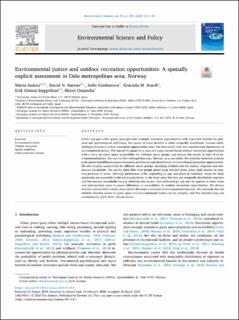| dc.contributor.author | Suárez, Marta | |
| dc.contributor.author | Barton, David Nicholas | |
| dc.contributor.author | Cimburova, Zofie | |
| dc.contributor.author | Gomez-Baggethun, Erik | |
| dc.contributor.author | Onaindia, Miren | |
| dc.date.accessioned | 2020-05-04T10:32:47Z | |
| dc.date.available | 2020-05-04T10:32:47Z | |
| dc.date.created | 2020-04-29T12:56:09Z | |
| dc.date.issued | 2020 | |
| dc.identifier.citation | Environmental Science and Policy. 2020, 108 133-143. | |
| dc.identifier.issn | 1462-9011 | |
| dc.identifier.uri | https://hdl.handle.net/11250/2653178 | |
| dc.description.abstract | Urban and peri-urban green Space provides multiple recreation opportunities With important benefits for physical and psychological well-being, but access to these benefits is often unequally distributed. Various methodologies to assess outdoor recreation opportunities exist, but they rarely take into consideration Dimensions of environmental justice. The aim of this paper is to mapand assess nature-based outdoor recreation opportunities with a focus on green space accessibility for different social groups, and discuss the results in light of environmental justice. We use the Oslo Metropolitan area, Norway, as a case study.We combine Statistical analysis With spatial modelling to assess recreation preferences and distribution of nature-based recreation opportunities. We also analyse Accessibility for different socialgroups, including children and the elderly, migrants and low Income households. Our results show that most People prefer large wooded green areas, high density of trees, and presence of water, although preferences differ depending on age and place of residence. Areas for daily recreationareaccessibletothewholepopulationinthestudyarea,butthey are unequally distributed, migrants and low-income households having relatively less access. Our methodology can also be Applied in other cities and metropolitan areas to assess differences in accessibility to outdoor recreation opportunities. We discuss whether and towhich extent these results illustrate a situation of environmental in justice. Weconclude that the relation between access to green Space and environmental justice can be complex, and that in justice may not automatically result from uneven access. | |
| dc.language.iso | eng | |
| dc.title | Environmental justice and outdoor recreation opportunities: A spatially explicit assessment in Oslo Metropolitan area, Norway | |
| dc.type | Peer reviewed | |
| dc.type | Journal article | |
| dc.description.version | publishedVersion | |
| dc.source.pagenumber | 133-143 | |
| dc.source.volume | 108 | |
| dc.source.journal | Environmental Science and Policy | |
| dc.identifier.doi | 10.1016/j.envsci.2020.03.014 | |
| dc.identifier.cristin | 1808657 | |
| dc.relation.project | Andre: Swedish Research Council for Environment | |
| dc.relation.project | Andre: German Aeronautics and Space Research Centre | |
| dc.relation.project | Andre: Agricultural Sciences | |
| dc.relation.project | Andre: National Science Centre (Poland) | |
| dc.relation.project | Andre: Spanish Ministry of Economy and Competitiveness | |
| dc.relation.project | Norges forskningsråd: XXXXXX | |
| dc.relation.project | Andre: Spatial Planning, Swedish Environmental Protection Agency | |
| cristin.ispublished | true | |
| cristin.fulltext | original | |
| cristin.qualitycode | 1 | |
